Painted benches. Murals. Sculptures. Installations and more. If you thought all this had to do with IIIT-Hyderabad’s annual cultural fest, Felicity, or was related to an event on campus, you couldn’t be more wrong. Turns out it’s all in a day’s work for the first year UG students at IIITH. From the next academic year, the All India Council for Technical Education (AICTE) has moved to make Humanities and Social Sciences mandatory for all Engineering students in India (except IITs and NITs). However this is not news at IIITH since the autonomous institute has always believed in an interdisciplinary approach to technical education with mandatory courses in Human Values and Humanities and Social Skills (HSS) in the first year of the undergraduate (UG) programme. It is a one year course spread over two semesters where students are expected to choose one out of the 5 artistic disciplines of HSS Skills: Folk Art and Painting, Sculpture, Presentation Movement, Raga and Rhythm, and Embroidery. These artistic disciplines come under the ambit of the Centre for Exact Humanities (CEH).
Unshackling The Spirit
In a previously recorded interview, the Head of the Centre, the late Prof. Navjyoti Singh said, “…This course is on imagination..because Arts involves cultivation of the imagination in every sense of the way. The courses offered here..from Sculpting, Painting, Music, and others help you open up the mind and let the imagination run free, in a way that one creates aesthetic sensibilities, and goodness in life….At the end of the course, we expect that you go for public display and public performance.”
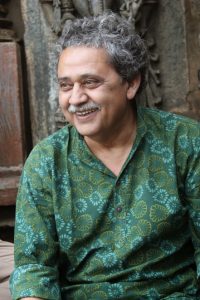
Echoing Prof. Navjyoti Singh’s view, Jayachandran Surendran, the faculty in charge of Presentational Movement, passionately talks about how there’s a common thread running between the various art disciplines. He says that he and his colleagues at CEH are working towards developing skills in Humanities and the mode they choose is one of these art practices. He emphasizes that the end form is secondary, while the means to achieving it is primary. “Some of the students are disappointed in that they say, they thought it was an art class and they would learn this or that, but for us, more than the completion of a composition or a painting, the process is more important (than the product)”, he says. Students are given credits for this course and obtaining their degree depends on it. They are incidentally not evaluated on their skills but more on their effort.
Stitching Stories
Pooja Chauhan’s class is illustrative of how the discipline itself is not all-important but merely serves as yet another avenue for opening up of the creative sensibilities. Last year, she was the faculty in-charge of Collage. This year, she is using Embroidery as a medium for collage. Pooja remarks that she is fortunate to have the freedom to experiment with different art forms to achieve the same result. From a historical perspective, sewing has always been viewed as a necessary evil (chore), especially for women, while embroidery served as a form of artistic expression. She says that apart from the fact that she loves embroidery and is proficient in it, she was keen on shattering some gender stereotypes. From the looks of it, her experiment is a success. A sneak peek into her class reveals a larger proportion of boys than girls, feet tapping, heads swaying to music, all the while deftly making gorgeous patterns and creating ‘compositions’ on various fabrics. These range from simple landscapes to more complex origami figures to the more popular insignia like Batman and others.
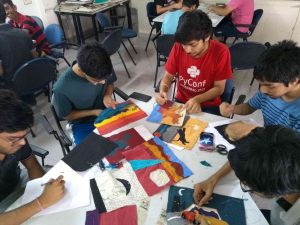
Rhythm in Movement
“I don’t teach dance, in the conventional sense of the word. My target is to make the students understand …how the body moves..”, says Jayachandran. At first, he lets them talk in class. They discuss societal issues and then express those thoughts in various ways of their choice. “For example, someone wants to do a skit on it, someone writes poetry and uses bodily movements to recite it, someone else wants to construct a story on it, they’re welcome.” Jayachandran says that his job is to stitch up these pieces together via the body. “We don’t create artists, but we definitely sow the seeds in the students. When the time is ripe or conducive, it will begin to sprout.,” he says with confidence.

Different Strokes
A search for the Painting and FolkArt class leads me to a dusty, rundown building near the main gate of the campus. On a hot, sweltering afternoon, they are standing amid a dump. Broken-down office furniture lies scattered around us; there are tyres, tubes and what looks like unwanted automobile spares. Sunil Lohar, faculty-in-charge of Folk Art and Painting, sketches an outline of a tree trunk on a bare wall of the dilapidated building. The sketch blends in and looks like an extension of an existing, large tree. He says he wants to give a face-lift to the area which currently is in ruins and generate interest even in casual onlookers. Why painted benches and painted walls? “I asked the students to step out of the classrooms and go speak with the inanimate objects and see what they have to say,” explains Sunil. What you see depicted is the students’ interpretation of their conversation with these everyday objects. Sunil says that the aim of the outdoor painting project is not only to give a voice to the inanimate objects but also a voice to the colours themselves.
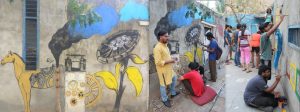
Sound Expressions
“To communicate, one does not need language,” smiles T.K. Saroja, the facilitator of Raaga and Rhythm at CEH. She says that she helps students express themselves through sounds, and this expression is what she terms as “music”. She says that there are certain universal concepts of music that transcend the genre, whether it is Hindustani or Carnatic. She exposes them to exercises that introduce rhythmic patterns in music that will eventually lead them to compose their own music. She incorporates songs in her classes to teach music. For example, she picks compositions that focus on patriotism, some that stand out for their melodic structures, and some for their sheer lyrical beauty. As I walk away from the class, the air is rent with voices singing in unison, “Tu Hi Ram Hai, Tu Rahim Hai”, and I understand what she means.
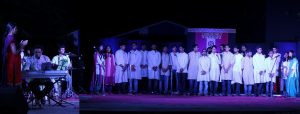
Figurative 3D art
The Studio, as it is popularly called, houses the brick kiln and it is here that classes on Sculpture are held. Shajil Padiyoor, faculty in charge of Sculpture, shows me a couple of drawing books where students are first encouraged to draw out a sketch of what they’re going to eventually mould with clay. Interestingly enough, when you sign up for Sculpture, you also unwittingly are a party to Photo Performance. “Preparing clay for sculpting takes some time, “ explains Shajil. In the interim, he engages his class with elaborate enactments of popular scenes from History or famous sculptures themselves.There’s a twist given to the sculptures by placing them in the current circumstances or environment. For example, a student depicts herself as the Statue of Liberty but in a saree with a traditional lantern as opposed to the torch. Then there’s the depiction of the famous sculpture of Laocoön and his sons, clad in lungis. These striking still-life portrayals are captured on film by professional photographers. “Just like how you use clay and mould it giving expression to your thoughts, in photo performance, the medium used is the human body. We mould and sculpt it through contortions, various facial expressions, and try to convey either subtle or direct messages”, says Shajil.
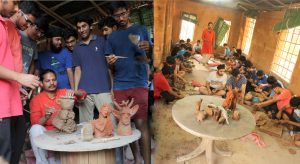
More recently, Shajil engaged his class in creating an outdoor 3D installation: a giant ‘spider’ web painstakingly strung together with dried leaves. There was a mirror mounted in front of a chair with the web in the background, inviting one to sit down and introspect. “The season was changing, and there were a lot of dried leaves all around. We brainstormed with Shajil sir and came up with this idea of creating an outdoor installation where we could use (natural) material found in abundance. When we sit on the chair and look at the mirror, we can see the web and it feels like we are stuck in the centre and can’t get out of it. The web is symbolic of all our entrapments…,” says a student of Sculpture.
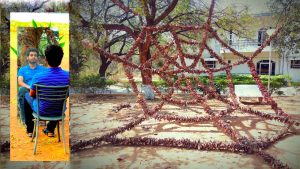
Art is not a Science but Science is an Art
What is the objective of the HSS skills course? The faculty at CEH are unanimous in their views. “The impression is that it is a hobby class, which it is NOT.”, says Saroja. Jayachandran agrees, “At the end of the course, we’ll be happy if their thought processes on human skills or humanities have improved, and not just if their dance skills have improved or their brush strokes have improved. Prof. Navjyoti Singh believed (and rightly so) that everyone is a born artist. Just like everyone deserves a Math education or a Science education, everyone deserves an Art education as well. And how just by learning Math or Science, no one becomes a Mathematician or a Scientist…similarly you don’t become an artist with just an Art education.” For Shajil, the realisation that art isn’t just about painting or sculpture, but present even in individual bodies, is a vindication of the course. Sunil Lohar says he’s surprised that when exposed to the colour palette, he finds that almost none of the students experiment with the primary colours, preferring the blacks and the greys. “At the end of the course, we just want them to become more colourful in life, “ he says optimistically.
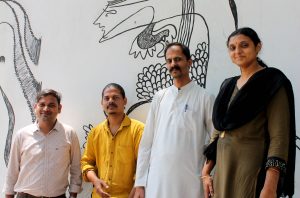

Sarita Chebbi is a compulsive early riser. Devourer of all news. Kettlebell enthusiast. Nit-picker of the written word especially when it’s not her own.


Next post